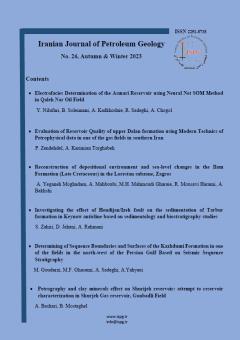بررسی اثر گسل هندیجان / ایذه بر رسوب گذاری سازند تاربور در تاقدیس کینو بر پایه مطالعات رسوب شناسی و بیواستراتیگرافی
الموضوعات : Sedimentology and analysis of sedimentary basins
صادق زهیری
1
![]() ,
داوود جهانی
2
,
داوود جهانی
2
![]() ,
علی رحمانی
3
,
علی رحمانی
3
![]()
1 - گروه زمین شناسی واحد تهران شمال دانشگاه آزاد اسلامی
2 - گروه زمین شناسی واحد تهران شمال دانشگاه آزاد اسلامی
3 - شرکت ملی نفت ایران
الکلمات المفتاحية: سازندتاربور, ماستریشتین, گسل هندیجان-ایذه, بلندای هندیجان,
ملخص المقالة :
الگوي چين خوردگی در کمربند چين خورده رانده زاگرس به شدت متأثر از رفتار مکانيکی واحدهاي سنگی آن وعملکرد گسلهاي پی سنگی با روندهاي متفاوت زاگرسی و عربی است و این فاکتور در خیلی جاها تاثیر مستقیمی بر الگوهای رسوبگذاری نهشته های فوقانی گذاشته که اغلب در پراکندگی رخساره و تغییرات ضخامتی نهشته ها دیده میشود در این مطالعه بر اساس مطالعات صحرایی، عکس های هوایی و مطالعه مقاطع نازک(33 عدد) تاثیر گسل هندیجان _ ایذه بر رسوبگذاری سازند تاربور با سن ماسترشتین در تاقدیس کینو و گسترش آن در تاقدیس ، مورد بررسی قرار گرفت. بر اساس مطالعات انجام شده تعداد 4 رخساره شناسایی شد و محیط رسوبی یک رمپ کربناته در نظر گرفته شد. سن رسوبات بر پایه مطالعات بیواستراتیگرافی ماسترشتین می باشد. بر اساس این مطالعه مشخص شد سازند تاربور با فاصله گرفتن از گسل هندیجان ایذه به سازند گورپی تبدیل می شود و به همین شکل در یال جنوبی تاقدیس کینو سازند گورپی بجای تاربور رسوب کرده است. بر این اساس می توان نتیجه گرفت که بلندای هندیجان در زمان رسوبگذاری تاربور در روند رسوب گذاری موثر بوده است. لذا پیشنهاد می شود بر اساس یافته های این مقاله نقشه زمین شناسی تاقدیس کینو مورد بازنگری قرار گیرد.
Abdollahie Fard, I., Sepehr, M., and Sherkati, S., 2011, Neogene salt in SW Iran and its interaction with Zagros folding: Geological Magazine, v. 148, no. 5-6, p. 854-867.
Allahkarampour Dill, M., Vaziri-Moghaddam, H., Seyrafian, A., and Behdad, A., 2018, Oligo-Miocene carbonate platform evolution in the northern margin of the Asmari intra-shelf basin, SW Iran: Marine and Petroleum Geology, v. 92, p. 437-461
Falcon, N. L., 1974, Southern Iran: Zagros Mountains, in Spencer, A., ed., Mesozoic-Cenozoic Orogenic Belts, Geological Society of London Special Publication 4, p. 199-211.
Ghabeishavi, A., Vaziri-Moghaddam, H., and Taheri, A., 2009, Facies distribution and sequence stratigraphy of the Coniacian–Santonian succession of the Bangestan Palaeo-high in the Bangestan Anticline, SW Iran: Facies, v. 55, no. 2, p. 243-257.
Ghabeishavi, A., Vaziri-Moghaddam, H., Taheri, A., and Taati, F., 2010, Microfacies and depositional environment of the Cenomanian of the Bangestan anticline, SW Iran: Journal of Asian Earth Sciences, v. 37, no. 3, p. 275-285.
James, G. A., and Wynd, J. G., 1965, Stratigraphic nomenclature of Iranian Oil Consortium Agreement Area: AAPG Bulletin, v. 49, no. 12, p. 2182–2245.
Laursen, G. V., Monibi, S., Allan, T. L., Pickard, N. A. H., Hosseiney, A., Vincent, B., Hamon, Y., Van Buchem, F. S. P., Moallemi, A., and Druillion, G., 2009, The Asmari Formation revisited: Changed stratigraphic allocation and new biozonation, First International Petroleum Conference and Exhibition: Shiraz, Iran.
Nikfard, M., 2023, Lower Eocene carbonate ramp clinoforms of the southern Tethys; Zagros Foreland Basin, SW Iran: Sequence stratigraphy architecture, basin physiography and carbonate factory controlling parameters, v. 35, no. 6, p. 2049-2077.
Parham, S., Piryaei, A. R., Ghorbani, M., and Moussavi-Harami, R., 2019, Paleogeographic evolution of the Maastrichtian deposits in the eastern Fars area (Zagros, Iran) using high-resolution sequence stratigraphic analysis: Carbonates and Evaporites, v. 34, no. 2, p. 315
. Piryaei, A., Reijmer, J. J. G., van Buchem, F. S. P., Yazdi-Moghadam, M., Sadouni, J., and Danelian, T., 2010, The influence of Late Cretaceous tectonic processes on sedimentation patterns along the northeastern Arabian plate margin (Fars Province, SW Iran): Geological Society, London, Special Publications, v. 330, no. 1, p. 211-251.
Rahmani, A., Taheri, A., Vaziri-Moghaddam, H., and Ghabeishavi, A., 2012, Biostratigraphy of the Asmari Formation at Khaviz and Bangestan Anticlines, Zagros Basin, SW Iran: Neues Jahrbuch für Geologie und Paläontologie-Abhandlungen, v. 263, no. 1, p. 1–16.
Sepehr, M., and Cosgrove, J. W., 2002, The major fault zones controlling the sedimentation, deformation and entrapment of hydrocarbon in the Zagros fold-thrust belt, Iran, AAPG Annual Meeting: Houston, Texas, p. 10-13.
-, 2007, The role of major fault zones in controlling the geometry and spatial organization of structures in the Zagros Fold–Thrust Belt: Geological Society, London, Special Publications, v. 272, p. 419-436
. Shabafrooz, R., Mahboubi, A., Vaziri-Moghaddam, H., Moussavi-Harami, R., Ghabeishavi, A., and Al-Aasm, I. S., 2015, Facies analysis and carbonate ramp evolution of Oligo-Miocene Asmari Formation in the Gachsaran and Bibi-Hakimeh oilfields and the nearby Mish anticline, Zagros Basin, Iran Neues Jahrbuch für Geologie und Paläontologie - Abhandlungen, v. 276, no. 1, p. 121-146.
Sherkati, S., and Letouzey, J., 2004, Variation of structural style and basin evolution in the central Zagros (Izeh zone and Dezful Embayment), Iran: Marine and Petroleum Geology, v. 21, no. 5, p. 535–554.
Van-Buchem, F., Allen, T., Gaumet, F., Karimi, Z., Laursen, G., Lotfpour, M., Masse, P., Moallemi, A., Monibi, A., Motiei, H., Tahmasbi, A. R., Vedrenne, V., and Vincent, B., 2006, The evolution of the Oligocene early Miocene mixed sedimentary system in the Dezful Embayment (SW Iran). Geo2006 Abstracts,GeoArabia, 12.
van_Buchem, F. S. P., Allan, T. L., G V Laursen, Lotfpour, M., Moallemi, A., Monibi, S., Motiei, H., Pickard, N. A. H., Tahmasbi, A. R., Vedrenne, V., and Vincent, B., 2010, Regional stratigraphic architecture and reservoir types of the Oligo-Miocene deposits in the Dezful Embayment (Asmari and Pabdeh Formations) SW Iran, in van_Buchem, F. S. P., Gerde, K. D., and Esteban, M., eds., Mesozoic and Cenozoic carbonate systems of the Mediterranean and the Middle East; stratigraphic and diagenetic reference models: London, Geological Society London Special Publications 329, p. 219-263.
Wynd, J. G., 1965, Biofacies of the Iranian consortium- agreement area: Iranian Offshore Oil Company.


